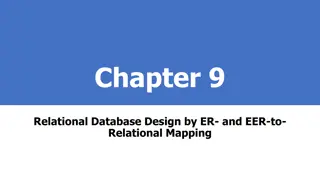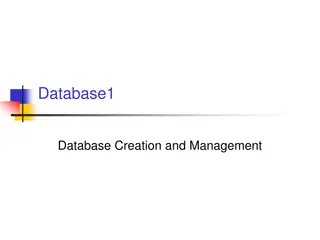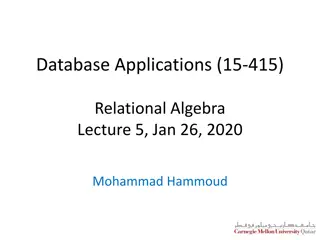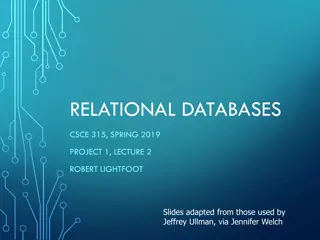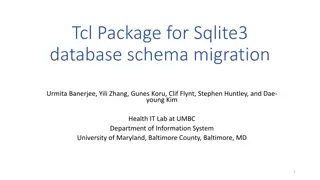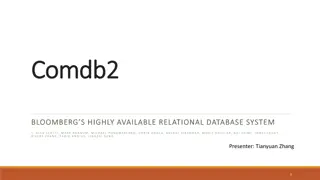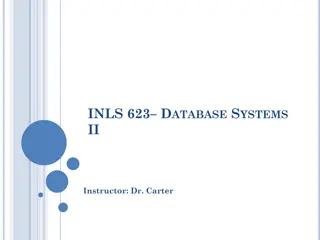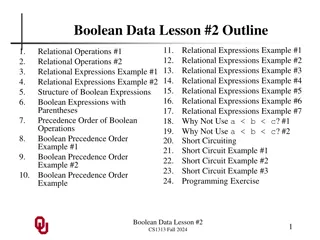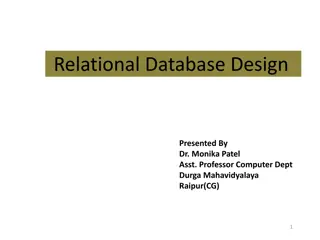Understanding Relational Database Design Principles
Explore the features of good relational design, including atomic domains and first normal form decomposition. Learn about functional dependency theory, algorithms, and database design processes. Discover the importance of atomicity in domain design and the implications of non-atomic values. Gain insights into lossless join decomposition and the benefits of combining related relations in database modeling.
Download Presentation

Please find below an Image/Link to download the presentation.
The content on the website is provided AS IS for your information and personal use only. It may not be sold, licensed, or shared on other websites without obtaining consent from the author. Download presentation by click this link. If you encounter any issues during the download, it is possible that the publisher has removed the file from their server.
E N D
Presentation Transcript
Features of Good Relational Design Atomic Domains and First Normal Form Decomposition Using Functional Dependencies Functional Dependency Theory Algorithms for Functional Dependencies Decomposition Using Multivalued Dependencies More Normal Form Database-Design Process Modeling Temporal Data
Suppose we combine instructor and department into inst_dept (No connection to relationship set inst_dept) Result is possible repetition of information
Consider combining relations sec_class(sec_id, building, room_number) and section(course_id, sec_id, semester, year) into one relation section(course_id, sec_id, semester, year, building, room_number) No repetition in this case
Lossless join decomposition Decomposition of R = (A, B, C) R1= (A, B) R2= (B, C) A B 1 2 r C A B A B B C 1 2 1 2 A B A,B(r) B,C(r) A B 1 2 C A B A (r) B (r)
Domain is atomic if its elements are considered to be indivisible units Examples of non-atomic domains: Set of names, composite attributes Identification numbers like CS101 that can be broken up into parts A relational schema R is in first normal form if the domains of all attributes of R are atomic Non-atomic values complicate storage and encourage redundant (repeated) storage of data Example: Set of accounts stored with each customer, and set of owners stored with each account
Atomicity is actually a property of how the elements of the domain are used. Example: Strings would normally be considered indivisible Suppose that students are given roll numbers which are strings of the form CS0012 or EE1127 If the first two characters are extracted to find the department, the domain of roll numbers is not atomic. Doing so is a bad idea: leads to encoding of information in application program rather than in the database.
Decide whether a particular relation Ris in good form. In the case that a relation Ris not in good form, decompose it into a set of relations {R1, R2, ..., Rn} such that each relation is in good form the decomposition is a lossless-join decomposition Our theory is based on: functional dependencies multivalued dependencies
Constraints on the set of legal relations. Require that the value for a certain set of attributes determines uniquely the value for another set of attributes. A functional dependency is a generalization of the notion of a key.
Let R be a relation schema The functional dependency holds onR if and only if for any legal relations r(R), whenever any two tuples t1and t2 of r agree on the attributes , they also agree on the attributes . That is, t1[ ] = t2 [ ] t1[ ] = t2 [ ] Example: Consider r(A,B ) with the following instance of r. R and R 1 1 5 3 7 4 On this instance, A B does NOT hold, but B A does hold.
K is a superkey for relation schema R if and only if K R K is a candidate key for R if and only if K R, and for no K, R Functional dependencies allow us to express constraints that cannot be expressed using superkeys. Consider the schema: inst_dept (ID, name, salary, dept_name, building, budget ). We expect these functional dependencies to hold: dept_name building and ID building but would not expect the following to hold: dept_name salary
We use functional dependencies to: test relations to see if they are legal under a given set of functional dependencies. If a relation r is legal under a set F of functional dependencies, we say that rsatisfies F. specify constraints on the set of legal relations We say that Fholds onR if all legal relations on R satisfy the set of functional dependencies F. Note: A specific instance of a relation schema may satisfy a functional dependency even if the functional dependency does not hold on all legal instances. For example, a specific instance of instructor may, by chance, satisfy name ID.
A functional dependency is trivial if it is satisfied by all instances of a relation Example: ID, name ID name name In general, is trivial if
Given a set F of functional dependencies, there are certain other functional dependencies that are logically implied by F. For example: If A B and B C, then we can infer that A C The set of all functional dependencies logically implied by F is the closure of F. We denote the closure of F by F+. F+ is a superset of F.
A relation schema R is in BCNF with respect to a set F of functional dependencies if for all functional dependencies in F+ of the form where R and R,at least one of the following holds: is trivial (i.e., ) is a superkey for R Example schema not in BCNF: instr_dept (ID, name, salary, dept_name, building, budget ) because dept_name building, budget holds on instr_dept, but dept_name is not a superkey
Suppose we have a schema R and a non-trivial dependency causes a violation of BCNF. We decompose R into: ( U ) ( R - ( - ) ) In our example, = dept_name = building, budget and inst_dept is replaced by ( U ) = ( dept_name, building, budget ) ( R - ( - ) ) = ( ID, name, salary, dept_name )
Constraints, including functional dependencies, are costly to check in practice unless they pertain to only one relation If it is sufficient to test only those dependencies on each individual relation of a decomposition in order to ensure that all functional dependencies hold, then that decomposition is dependency preserving. Because it is not always possible to achieve both BCNF and dependency preservation, we consider a weaker normal form, known as third normal form.
A relation schema R is in third normal form (3NF) if for all: in F+ at least one of the following holds: is trivial (i.e., ) is a superkey for R Each attribute A in is contained in a candidate key for R. (NOTE: each attribute may be in a different candidate key) If a relation is in BCNF it is in 3NF (since in BCNF one of the first two conditions above must hold). Third condition is a minimal relaxation of BCNF to ensure dependency preservation (will see why later).
Let R be a relation scheme with a set F of functional dependencies. Decide whether a relation scheme Ris in good form. In the case that a relation scheme Ris not in good form, decompose it into a set of relation scheme {R1, R2, ..., Rn} such that each relation scheme is in good form the decomposition is a lossless-join decomposition Preferably, the decomposition should be dependency preserving.
There are database schemas in BCNF that do not seem to be sufficiently normalized Consider a relation inst_info (ID, child_name, phone) where an instructor may have more than one phone and can have multiple children ID 99999 99999 99999 99999 child_name David David William Willian phone 512-555-1234 512-555-4321 512-555-1234 512-555-4321 inst_info
There are no non-trivial functional dependencies and therefore the relation is in BCNF Insertion anomalies i.e., if we add a phone 981- 992-3443 to 99999, we need to add two tuples (99999, David, 981-992-3443) (99999, William, 981-992-3443)
Therefore, it is better to decompose inst_info into: ID child_name David David William Willian 99999 99999 99999 99999 inst_child ID phone 512-555-1234 512-555-4321 512-555-1234 512-555-4321 99999 99999 99999 99999 inst_phone This suggests the need for higher normal forms, such as Fourth Normal Form (4NF), which we shall see later.
We now consider the formal theory that tells us which functional dependencies are implied logically by a given set of functional dependencies. We then develop algorithms to generate lossless decompositions into BCNF and 3NF We then develop algorithms to test if a decomposition is dependency-preserving
Given a set F set of functional dependencies, there are certain other functional dependencies that are logically implied by F. For e.g.: If A B and B C, then we can infer that A C The set of all functional dependencies logically implied by F is the closure of F. We denote the closure of F by F+.
We can find F+, the closure of F, by repeatedly applying Armstrong s Axioms: if , then (reflexivity) if , then (augmentation) if , and , then (transitivity) These rules are sound (generate only functional dependencies that actually hold), and complete (generate all functional dependencies that hold).
R = (A, B, C, G, H, I) F = { A B A C CG H CG I B H} some members of F+ A H by transitivity from A B and B H AG I by augmenting A C with G, to get AG CG and then transitivity with CG I CG HI by augmenting CG I to infer CG CGI, and augmenting of CG H to infer CGI HI, and then transitivity
To compute the closure of a set of functional dependencies F: F + = F repeat + until F + does not change any further for each functional dependency f in F+ apply reflexivity and augmentation rules on f add the resulting functional dependencies to F + for each pair of functional dependencies f1and f2 in F + iff1 and f2 can be combined using transitivity then add the resulting functional dependency to F NOTE: We shall see an alternative procedure for this task later
Additional rules: If holds and holds, then holds (union) If holds, then holds and holds (decomposition) If holds and holds, then holds (pseudotransitivity) The above rules can be inferred from Armstrong s axioms.
Given a set of attributes a, define the closureof a underF (denoted by a+) as the set of attributes that are functionally determined by a under F Algorithm to compute a+, the closure of a under F result := a; while (changes to result) do for each in F do begin if result then result := result end
R = (A, B, C, G, H, I) F = {A B A C CG H CG I B H} (AG)+ 1. result = AG 2. result = ABCG (A C and A B) 3. result = ABCGH (CG H and CG AGBC) 4. result = ABCGHI Is AG a candidate key? 1. Is AG a super key? 1. Does AG R? == Is (AG)+ R 2. Is any subset of AG a superkey? 1. Does A R? == Is (A)+ R 2. Does G R? == Is (G)+ R (CG I and CG AGBCH)
There are several uses of the attribute closure algorithm: Testing for superkey: To test if is a superkey, we compute +, and check if + contains all attributes of R. Testing functional dependencies To check if a functional dependency holds (or, in other words, is in F+), just check if +. That is, we compute + by using attribute closure, and then check if it contains . Is a simple and cheap test, and very useful Computing closure of F For each R, we find the closure +, and for each S +, we output a functional dependency S.
Sets of functional dependencies may have redundant dependencies that can be inferred from the others For example: A C is redundant in: {A B, B C, A C} Parts of a functional dependency may be redundant E.g.: on RHS: {A B, B C, A CD} can be simplified to {A B, B C, A D} E.g.: on LHS: {A B, B C, AC D} can be simplified to {A B, B C, A D} Intuitively, a canonical cover of F is a minimal set of functional dependencies equivalent to F, having no redundant dependencies or redundant parts of dependencies
Consider a set F of functional dependencies and the functional dependency in F. Attribute A is extraneous in if A and F logically implies (F { }) {( A) }. Attribute A is extraneous in if A and the set of functional dependencies (F { }) { ( A)} logically implies F. Note: implication in the opposite direction is trivial in each of the cases above, since a stronger functional dependency always implies a weaker one Example: Given F = {A C, AB C } B is extraneous in AB C because {A C, AB C} logically implies A C (I.e. the result of dropping B from AB C). Example: Given F = {A C, AB CD} C is extraneous in AB CD since AB C can be inferred even after deleting C
Consider a set F of functional dependencies and the functional dependency in F. To test if attribute A is extraneous in 1. compute ({ } A)+ using the dependencies in F 2. check that ({ } A)+ contains ; if it does, A is extraneous in To test if attribute A is extraneous in 1. compute + using only the dependencies in F = (F { }) { ( A)}, 2. check that + contains A; if it does, A is extraneous in
A canonical coverfor F is a set of dependencies Fc such that F logically implies all dependencies in Fc, and Fclogically implies all dependencies in F, and No functional dependency in Fccontains an extraneous attribute, and Each left side of functional dependency in Fcis unique. To compute a canonical cover for F: repeat Use the union rule to replace any dependencies in F 1 1 and 1 2 with 1 1 2 Find a functional dependency with an extraneous attribute either in or in /* Note: test for extraneous attributes done using Fc, not F*/ If an extraneous attribute is found, delete it from until F does not change Note: Union rule may become applicable after some extraneous attributes have been deleted, so it has to be re-applied
R = (A, B, C) F = {A BC B C A B AB C} Combine A BC and A B into A BC Set is now {A BC, B C, AB C} A is extraneous in AB C Check if the result of deleting A from AB C is implied by the other dependencies Yes: in fact, B C is already present! Set is now {A BC, B C} C is extraneous in A BC Check if A C is logically implied by A B and the other dependencies Yes: using transitivity on A B and B C. Can use attribute closure of A in more complex cases The canonical cover is: A B B C
For the case of R = (R1, R2), we require that for all possible relations r on schema R r = R1(r ) R2(r ) A decomposition of R into R1 and R2 is lossless join if at least one of the following dependencies is in F+: R1 R2 R1 R1 R2 R2 The above functional dependencies are a sufficient condition for lossless join decomposition; the dependencies are a necessary condition only if all constraints are functional dependencies
R = (A, B, C) F = {A B, B C) Can be decomposed in two different ways R1 = (A, B), R2 = (B, C) Lossless-join decomposition: Dependency preserving R1 = (A, B), R2 = (A, C) Lossless-join decomposition: Not dependency preserving (cannot check B C without computing R1 R1 R2 = {B} and B BC R1 R2 = {A} and A AB R2)
Let Fibe the set of dependencies F + that include only attributes in Ri. A decomposition is dependency preserving, if (F1 F2 Fn )+ = F + If it is not, then checking updates for violation of functional dependencies may require computing joins, which is expensive.
To check if a dependency is preserved in a decomposition of R into R1, R2, , Rn we apply the following test (with attribute closure done with respect to F) result = while (changes to result) do for eachRiin the decomposition t = (result Ri)+ Ri result = result t If result contains all attributes in , then the functional dependency is preserved. We apply the test on all dependencies in F to check if a decomposition is dependency preserving This procedure takes polynomial time, instead of the exponential time required to compute F+and(F1 F2 Fn)+
R = (A, B, C ) F = {A B B C} Key = {A} R is not in BCNF Decomposition R1 = (A, B), R2 = (B, C) R1and R2 in BCNF Lossless-join decomposition Dependency preserving
To check if a non-trivial dependency causes a violation of BCNF 1. compute + (the attribute closure of ), and 2. verify that it includes all attributes of R, that is, it is a superkey of R. Simplified test: To check if a relation schema R is in BCNF, it suffices to check only the dependencies in the given set F for violation of BCNF, rather than checking all dependencies in F+. If none of the dependencies in F causes a violation of BCNF, then none of the dependencies in F+ will cause a violation of BCNF either. However, simplified test using only F isincorrectwhen testing a relation in a decomposition of R Consider R = (A, B, C, D, E), with F = { A B, BC D} Decompose R into R1 =(A,B) and R2 =(A,C,D, E) Neither of the dependencies in F contain only attributes from (A,C,D,E) so we might be mislead into thinking R2 satisfies BCNF. In fact, dependency AC D in F+ shows R2 is not in BCNF.
To check if a relation Ri in a decomposition of R is in BCNF, Either test Ri for BCNF with respect to the restriction of F to Ri (that is, all FDs in F+ that contain only attributes from Ri) or use the original set of dependencies F that hold on R, but with the following test: for every set of attributes Ri, check that + (the attribute closure of ) either includes no attribute of Ri- , or includes all attributes of Ri. If the condition is violated by some in F, the dependency ( + - ) Ri can be shown to hold on Ri, and Ri violates BCNF. We use above dependency to decompose Ri
result := {R }; done := false; compute F +; while (not done) do if (there is a schema Riin result that is not in BCNF) then begin let be a nontrivial functional dependency that holds on Risuch that Riis not in F +, and = ; result := (result Ri ) (Ri ) ( , ); end else done := true; Note: each Riis in BCNF, and decomposition is lossless-join.
R = (A, B, C ) F = {A B B C} Key = {A} R is not in BCNF (B C but B is not superkey) Decomposition R1 = (B, C) R2 = (A,B)
It is not always possible to get a BCNF decomposition that is dependency preserving R = (J, K, L ) F = {JK L L K } Two candidate keys = JK and JL R is not in BCNF Any decomposition of R will fail to preserve JK L This implies that testing for JK L requires a join
There are some situations where BCNF is not dependency preserving, and efficient checking for FD violation on updates is important Solution: define a weaker normal form, called Third Normal Form (3NF) Allows some redundancy (with resultant problems; we will see examples later) But functional dependencies can be checked on individual relations without computing a join. There is always a lossless-join, dependency-preserving decomposition into 3NF.
Relation dept_advisor: dept_advisor (s_ID, i_ID, dept_name) F = {s_ID, dept_name i_ID, i_ID dept_name} Two candidate keys: s_ID, dept_name, and i_ID, s_ID R is in 3NF s_ID, dept_name i_ID s_ID dept_name is a superkey i_ID dept_name dept_name is contained in a candidate key
There is some redundancy in this schema Example of problems due to redundancy in 3NF R = (J, K, L) F = {JK L, L K } J j1 j2 j3 L l1 l1 l1 l2 K k1 k1 k1 k2 null repetition of information (e.g., the relationship l1, k1) (i_ID, dept_name) need to use null values (e.g., to represent the relationship l2, k2 where there is no corresponding value for J). (i_ID, dept_nameI) if there is no separate relation mapping instructors to departments


